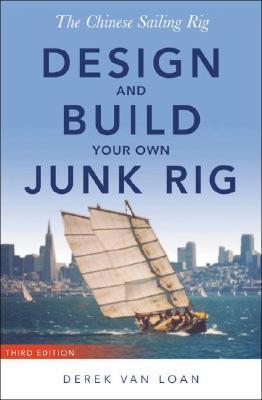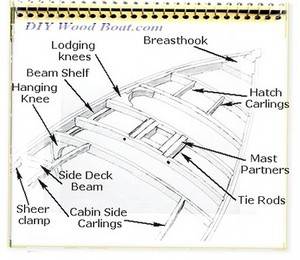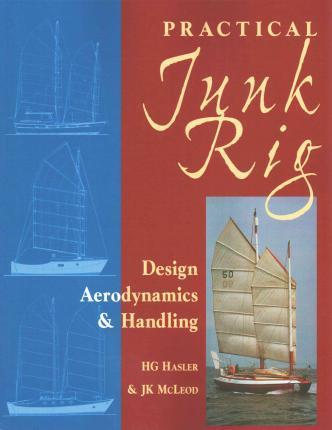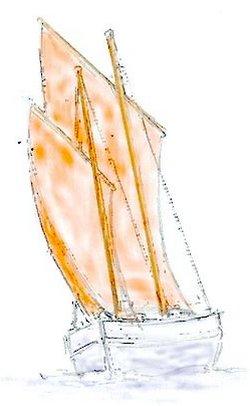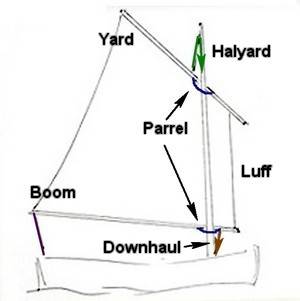- Home
- Sailing Rigs
- Lug Rigs
- Chinese Junk
- Junk Rig Conversion
Junk Rig
Conversion
Structural
Considerations
A
junk rig conversion is possible for almost any boat
However, as it works best with an unstayed mast there are hull structural considerations to take into account.
Before you begin designing the sail plan you need to check the existing structure of your boat to determine where the mast or masts can be sited.
If you are converting from a bermudan rig the new mast will want to be set further forward, so it will require a suitable supporting structure.
Once you know where it is possible to place the mast, then work on a sail plan to suit.
Why convert?
If you have read this far I guess that you have already conceived some ideas of why you think a junk rig conversion is right for you.
So I will only enumerate some of the advantages.
Junk rig is the easiest rig to handle particularly if you are short
handed.
Reefing easy and quick with all the control lines running back to the
cockpit.
The sail is self tacking and self stowing when dropped.
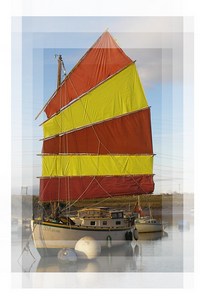
The structural loads on the hull are less
than for a stayed bermudan
rig.
However, the junk rig is a cruising rig, if you are into racing forget
it,
unless you can compete against other junk rigs.
Boats with a deep forefoot and or long keel can be slow in stays,
however this
can be over come with a better rudder or using a foresail for backing.
You might be able to allay some of the cost of conversion by selling
the old
rig and sails, especially if it is one of the popular rigs.
And you can use the old sail material if it is in reasonable condition.
affiliate linksMast Position

Because of the nature
of the rig a junk sail works best on an
unstayed mast.
And with most junk rig conversions the mast will need to be positioned
forward
of the bermudan mast position.
So, before you start to design the sail you need to check your boat for
a
suitable position mast, then design the sail plan to suit.
Positioning a junk sail is about getting the sail’s CE (Centre of
Effort)
positioned in front of the hull’s CLR (Centre of Lateral
Resistance).
Too far aft and it will develop too much weather helm too far forward,
lee
helm.
The CLR will be fixed by the shape of the hull.
The CE will depend on the size and shape of the sail plan.
The sail plan can vary enormously, depending on the aspect ration,
number of
sails etc, and of course it will depend on the mast position.
Having said all that, it is rare for a junk rig to suffer from much lee helm, weather helm is much more common, so the further forward the CE the better.

However, this is not
an
exact science, the CE of a sail will alter as the wind strength alters
and as
you trim or reef the sail.
The CLR of the hull will alter somewhat as the boat heels and the
underwater
shape alters.
It is because of the desirability of having an unstayed mast
that the junk
rig conversion of catamarans can be problematic, though some have
gotten around
this by having a twin rig with a mast in each hull.
And shrouds can be used though this will greatly reduce the versatility of the rig.
Tabernacles have been used on some smaller
boat junk rig conversions
but they
still need as much bury between the pivot and heel as for fixed masts,
this
calls for an intrusive ‘slot’ extending below decks.
The CE can be moved forward by raking the mast forward.
Forward rake is seen on many Chinese
multi-masted
vessels but with a single masted junk rig conversion there is a danger
that
this may cause too much downwards press on bow.
For a single masted rig the recommended rake is 'plum'.
Junk Rig Conversion Structural Considerations
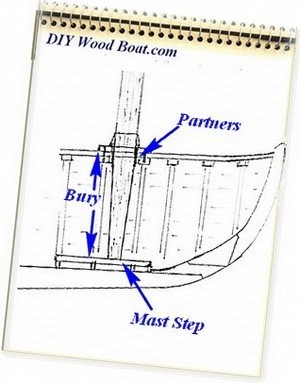
The first consideration
for a junk rig conversion is having sufficient ‘bury’ to support
the mast.
An unstayed mast is only attached to the boat at the mast step and at
the
partners, the distance between these is known as the ‘bury’.
As a rough guide this should not be less than 1/10th of mast height
above the
deck or the length of boat.
The next consideration is how the loads on the mast will be transferred
and
spread to and from these two positions.
Even though loads on a junk mast are less than with a bermudan rig they
can
still be considerable.
So, the mast partners and the mast step need to be strong, affixed to main beams, bulkheads or floors and able to spread the loads without causing undue strain on the hull shape.
First check that there are suitable floor timbers across which to fit a
‘keel step’.
This should span and be fixed to at least two floors, preferably more.
The mast step should be strong enough to take loading in any direction, particularly sideways, towards aft and vertically down.
Then
have a look at the
deck beams to see if there is a suitable position to place the ‘mast
partners’ directly above the ‘keel step’ position.
The partners support the mast at deck level and spread loads across the
deck.
They should be supported between two main deck beams and two carlines
and
reinforced with tie bars and logging knees.
Once you have established where you can put the mast then you can design the sail plan to suit your junk rig conversion.
affiliate linksDeck Layout
Before
you begin any alterations consider the deck layout.
Moving the mast forward might necessitate moving the fore hatch, so you
need to
plan where this will go, whether it will snag any lines etc.
This brings us on to those control lines, where they will be routed etc.
The lines coming vertically down the mast need to change direction through ninety degrees so they can be lead to the cockpit, this requires a block for each and somewhere secure to anchor the block.
Plan the position of blocks sheet and halyard leads to reduce the
number of
‘corners’, the fewer changes in direction the less will be the
friction.
Consider also the helm position and where to place cleats, winches etc.
And the position of the sheet horse or traveller is another factor which might affect the design of the sail plan.
Sheets drooping into cockpit can be a nuisance and even a hazard if
they get
caught during a gibe, on the other hand the sheets need sufficient lead.
It is also worth bearing in mind even at this stage that there will be
times
when there will be a lot of rope in the cockpit.
Being able to stow it all neatly safely and quickly needs some thought
not just
about the means of stowage but the position of the lines.
Take your time planning your junk rig conversion and try to consider all aspects in relation to the whole.
affiliate links
Previous posts
See What Others Have Posted
Biplane keel stepped masts on Tiki 38
We are building a Wharram Tiki 38 and really like the idea of a junk rig.
We saw pics of same vessel 'Aorai' with a Biplane keel stepped junk rig and …
